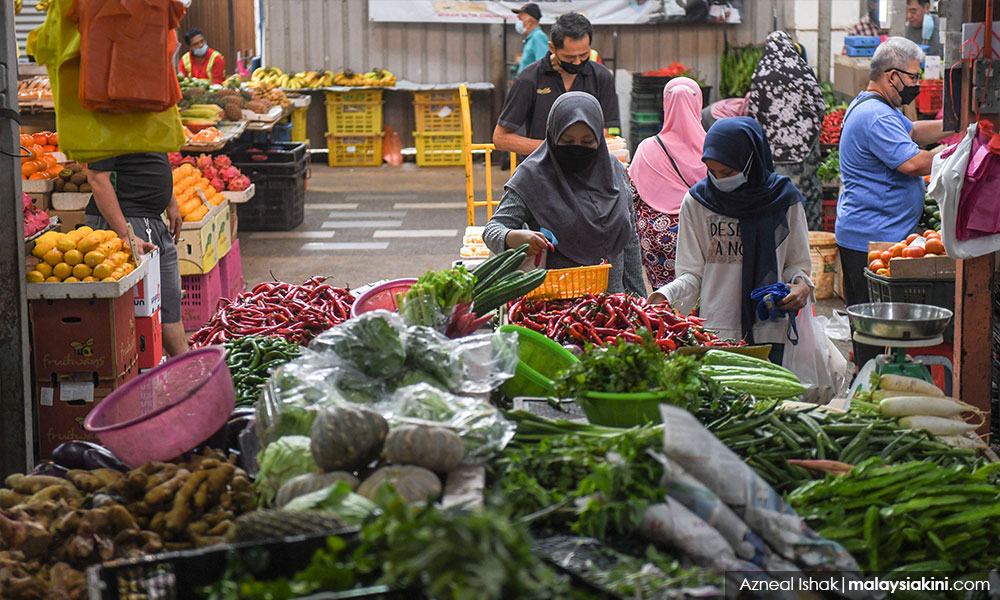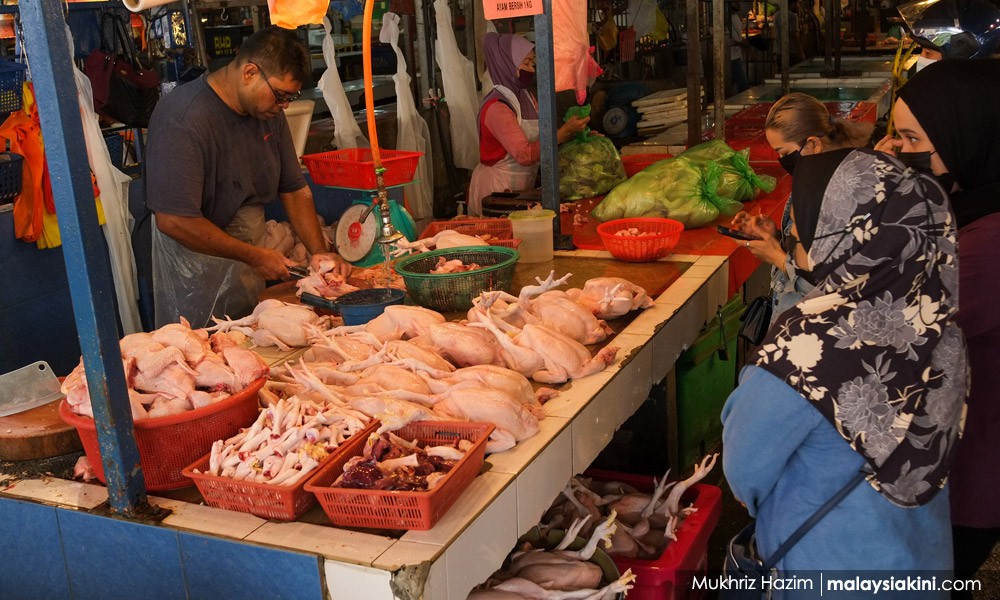As the global food system shudders with every blast that strikes Ukraine, cracks have started forming in Malaysia’s food security landscape, exposing policies that prioritise cash crops over food cultivation, experts said.
Disjointed agriculture policies over the years, monopolies in local production and imports, and research-deficient agricultural practices are likely factors that led to Malaysia’s food insecurity today.
Describing the pre-independence economy to be largely extractive of the country’s natural resources, Universiti Putra Malaysia Institute of Tropical Agriculture and Food Security research fellow Fatimah Mohamed Arshad said Malaysia’s economy remained largely agrarian until the country started diversifying in the 1970s.
“But we have to thank them for bringing rubber trees from Brazil and oil palm from Africa,” the professor quipped, explaining that the country’s coloniser’s commodity-dependent economy initially flourished on rubber and tin.
Since then, she said, the country’s agricultural efforts have been lopsided to favour cash crops, epitomised in monocrop oil palm plantations across 80 percent of the country’s agricultural land, covering 5.9 million hectares.

This is despite three national agriculture policies from 1984 to 2010, two national agrifood policies since 2011 and 40 different laws regulating food and food security.
According to the Department of Statistics, the country experienced a trade deficit in food products amounting to RM21.7 billion in 2020 as the nation had imported food products worth RM55.5 billion while exporting only RM33.8 billion.
The trade deficit in this sector was a 24.9 percent spike from the previous year.
Malaysia’s food supply per capita has grown over the years, but much of the growth is due to imports, read a study by Khazanah Research Institute on food security published in 2019.
In 1961, the supply of vegetables per capita went up from 20kg in 1961 to 72kg in 2013, the paper authored by renowned economist Jomo KS and researchers Tan Zhai Gen and Jarud Romadan Khalidi noted. However, the increase was attributed to the import of vegetables rather than greater production, the paper titled “Achieving Food Security for all Malaysians” stated.
It explained that although the production of vegetables had increased 10-fold, imports had grown 14-fold.

The researchers said the policy on self-sufficiency was primarily focused on rice cultivation, while another agricultural focus was on producing cash crops mostly for exports, thus reducing the diversity of food produced.
They said the country’s constitution did not explicitly guarantee the right to adequate food, nor has there been a comprehensive national food policy document despite the long-standing importance of food security and nutrition.
“Malaysian food policies have not only compromised food affordability, especially for rice and many imported foods but also contributed micronutrient deficiencies and diet-related non-communicable diseases,” read the discussion paper.
A Bank Negara Malaysia 2021 Box Report on “Closing the Food Gap” revealed that 13 out of 14 items that were below self-sufficiency levels in 2011 had remained so even after a decade.
The food basket surveyed in 2019 for household expenditure by the Department of Statistics may have revealed what these items are. It reported that 14.1 percent of the items frequently spent on were imported, and they were onion, dairy products, coffee, wheat flour, tea, shallots, potato and cooking oil.
Bernas monopoly
Even though rice self-sufficiency was a policy focus, rice production still cannot totally meet the nation’s demand, Fatimah said.
As of 2020, Malaysia is only able to meet 63 percent of the domestic rice demand and not the 70 percent target stated in the National Agrofood Policy set to be achieved by that same year.
This is despite 88 percent of agriculture subsidies and 45 percent of total agriculture budget spending being directed to this sector.
Questioning the successes of government policies, Fatimah said the government-linked company Beras Nasional (Bernas) was given too much control when it took full control of the rice industry in Malaysia.
She said the 50 years of monopoly stifled the industry, and unlike other rice producers like Japan, Korea and Thailand, Malaysia had not researched the full capacity of the paddy plant.
“We only extract paddy for rice, rice noodles (mee hoon) and cooling powder (bedak sejuk).
“In other countries, they have found a use for the plant in construction, pharmaceuticals, beauty products and even high-grade rice wine,” said Fatimah.
The monopoly happened when the National Paddy and Rice Board Act 1971 was repealed, leaving the rice industry under the control of Bernas before it was eventually sold to private hands.

The Bernas monopoly meant farmers were obliged to accept much higher ‘deductions’ on paddy sold by them to millers, which have increased from 14 to 17 percent in the 1970s to over 20 percent more recently, the KRI study noted.
Besides the monopoly of the rice industry in Malaysia, privatisation in more recent years has led to monopolies moving from the public to the private sector and government subsidies increasingly captured by private rentiers instead. This also happened in the food industry.
“Hence the food system had caused Malaysia to become more dependent on and dominated by a few politically influential food monopolies, and one example was the consolidation and monopoly of the rice industry under Bernas,” the KRI paper noted.
Approved permits
Meanwhile, Fatimah said, “agricultural input” like fertilisers and animal feed were major contributors to low margins that were also plaguing productivity in this sector.
The Department of Statistics revealed in 2020 that the feedstocks and foodstuff index had increased 24.4 percent over the past 10 years.
“Our yield is low, and our input, mostly imported, is growing pricier. This increases the cost of production.
“While all these years we did not do enough to increase productivity, when the cost of production increases, consumers pay the high price,” she explained.
Malaysia imports almost all of its animal feed, with approximately 80 percent of its grain corn coming from Brazil and Argentina, while 96 percent of soybean from Argentina.
Owing to supply disruption in grain exporting countries, the price of grain corn had skyrocketed 217 percent over the past year, resulting in higher poultry farming costs and retail prices of poultry meat.

Besides chicken, the retail prices of other agro-food items also shot up, among others, due to currency devaluation making imports more expensive.
In response, the government recently announced that approved permits (AP) are no longer required for imports of agro-food commodities like cabbage, old coconut, chicken and liquid milk.
This announcement was met by surprise by many consumers who were not aware that such APs were required for food imports.
However, the AP system was highlighted by KRI researchers as being inefficient due to the non-transparent manner in which they are allocated.
Fatimah said the fact that we have to dole out APs to import vegetables shows the dire state of our agriculture landscape.
“If we can’t even produce our own cabbage, that is the state of our agriculture. And somebody has been enjoying the AP for cabbage since 1980,” she said.
According to Department of Statistics, round cabbage was among eight items that exceeded 50 percent important dependency.
Huge research deficit
One way to ensure better food security is to emulate the agricultural practices of Vietnam, India and Thailand, which have invested heavily in research for innovative farming and production, Fatimah said.
She said Thai farmers had consulted Dutch experts to improve their livestock, while Indian farmers had consulted Israelis, whose expertise in vegetable farming had helped the world’s poorest nation, Ethiopia, to produce their food.
Fatimah said Vietnam universities based their research facility near farms and had strong collaborations between the government, scientists and the “extension agents”, who are officers who facilitated the transfer of technology from the lab to farms.
“In Malaysia, the universities are more focused on ranking while Mardi (the Malaysian Agriculture Research and Development Institute) does the research but does not have the transfer via extension agents,” she said.
“There is a big deficit in research in Malaysia and a lack of coordination between the government and the private sector,” she said.
Fatimah also called on a shift from big monopolies to smaller mills, something she believes could be a key to productivity-enhancing innovation.
In the 1970s and 1980s, she said, there were about 2,000 small rice mills across the nation, but today, there are much fewer but larger mills belonging to Bernas.
“In Malaysia, we have all big mills from rubber to paddy. Not many share my view, but I think small mills are a game-changer.
“Small mills will help the producers sell directly, to move upward to utilise the machines, and this will encourage innovation to come up with their products for consumption,” Fatimah explained. - Mkini




No comments:
Post a Comment
Note: Only a member of this blog may post a comment.